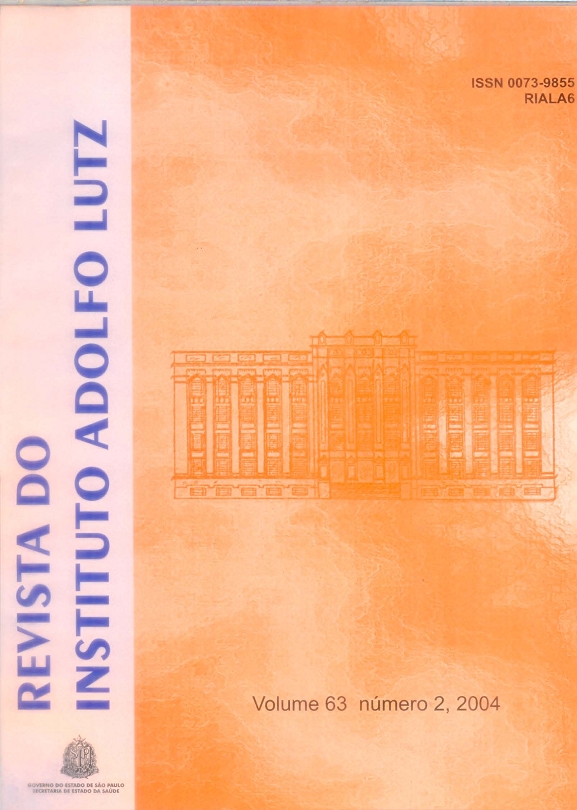Resumo
Um estudo comparativo sobre a ação de diversos fixadores utilizados em microscopia eletrônica de transmissão (MET) e microscopia de luz (ML) foi realizado, a fim de analisar a preservação de estruturas celulares ao microscópio eletrônico de transmissão (MET). Fragmentos de fígado de camundongo foram fixados em 5 diferentes fixadores: o fixador de Karnovsky, glutaraldeído e paraformaldeído utilizados no processamento para MET e o formaldeído comercial e líquido de Bouin utilizados no processamento para ML. Após a fixação, os fragmentos foram pós-fixados com tetróxido de ósmio e contrastastados com acetato de uranila. A seguir foram desidratados e incluídos em resina Epon. Os cortes ultrafinos mostraram que os fragmentos fixados com Karnovsky e glutaraldeído apresentaram melhor preservação das estruturas celulares e menor extração. O paraformaldeído produziu alguns artefatos de má fixação e extração pelo fato de formar menos ligações cruzadas que o glutaraldeído. Os fixadores formaldeído comercial e o líquido de Bouin utilizados em microscopia de luz mostraram que não são adequados ao uso em MET, pois são considerados fixadores coagulantes e produzem extensa extração dos componentes celulares. Comparando-se as imagens obtidas com os fixadores utilizados, o fixador de Karnovsky e o glutaraldeído mostraram melhor preservação e maior similaridade na morfologia.
Referências
1. Baker JR The fine structure produced in cells by fixatives. JIR Microsc Soc, 84: 115, 1965.
2. Bowers B, Maser M. Artifacts in fixation for transmission electron microscopy. In: RFE Crang and KL Klomparens. Artifacts in Biological Electron Microscopy. Plenum Press, New York,. P 13-42, 1988.
3. Glauert AM Practical methods in Electron microscopy - Fixation, dehydration and embedding of biological specimens. Strangeways Research Laboratory, Cambridge. North-Holland Publishing Companys, Amsterdam, Oxford; 1975.
4. Glauert AM, Rogers GE, Glauert RH. A new embedding medium for electron microscopy. Nature, London, 178: 803, 1956.
5. Hayat MA. Principles and techniques of electron microscopy: Biological applications. Van Nostrand Reinhold, New York; 1970.
6. Holt SJ, Hicks RM. Studies on formalin fixation for electron microscopy and cytochemical staining purposes. J Biophys Biochem Cytol, 11: 31, 1961.
7. Karnovsky MJ. A formaldehyde-glutaraldehyde fixative of high osmolarity for use in electron microscopy. J Cell Biol , 27: 137 A, 1965.
8. Lewis PR, Knight DP, Williams MA. Staning methods for thin sections, in : AM Glauert, ed. Practical methods in electron microscopy. North-Holland, Amsterdam; 1974.
9. Luft JH. Improvements in epoxy resin embedding methods. J. Biophys Biochem. Cytol. , 9: 409, 1961.
10. Palade GE. A study of fixation for electron microscopy. J. Exp Med, 95:285, 1952.
11. Pease DC. Histological technique for electron microscopy. 2nd edition. Academic Press, New York and London; 1964.
12. Porter KR; Blum J. A study of microtomy for electron microscopy. Anat Rec, 117: 685, 1953.
13. Reynolds ES. The use of lead citrate at high pH as na electron-opaque stain in electron microscopy. J. Cell. Biol. , 17:208, 1963.
14. Riemersma JC. Osmium tetroxide fixation of lipids for electron microscopy. A possible reaction mechanism. Biochim. Biophys Acta, 152: 718, 1968.
15. Robertson JD, Bodenheimer TS, Stage DE The ultrastructure of Maunther cell synapses and nodes in goldfish brain. J. Cell. Biol ., 19: 159, 1963.
16. Sabatini DD, Bensch K, Barrnett RJ. Cytochemistry and electron microscopy. The preservation of cellular ultrastructure and enzymatic activity by aldehyde fixation. J. Cell. Biol., 17: 19, 1963.
17. Souto Padron T Imunocitoquímica : Técnicas Pré e Pós-Inclusão. In: Haddad A et al., editor W. de Souza. Técnicas Básicas de Microscopia Eletrônica Aplicadas às Ciências Biológicas. Rio
de Janeiro: Sociedade Brasileira de Microscopia, P 116-25, 1998.
18. Stein O, Stein Y. Light and electron microscopy radioautography of lipids: techniques and biological applications. Adv. Lipid. Res. , 9:1, 1971.
19. Strangeways TSP, Canti RG. The living cell in vitro as shown by darkground illumination and the changes induced in such cells by fixing reagents. Q. JI microsc. Sci., 71: 1, 1927.
20. Wrigglesworth JM, Packer L. pH-dependent conformational change in submitochondrial particles. Arch. Biochem. Biophys., 133: 194, 1969.

Este trabalho está licenciado sob uma licença Creative Commons Attribution 4.0 International License.
Copyright (c) 2004 Daniel S. Abrahão, Ana Rita Toledo Piza, Marilena dos Anjos Martins, Jacinto C. Silva Neto, Elaine C. J. Ferreira, Ludmila Nakamura Rapado, Tânia Matiko Hosoda, Raquel C. Silva, Ana Carolina Azzuz, Noemi Nosomi Taniwaki, Maria de Fátima Costa Pires
